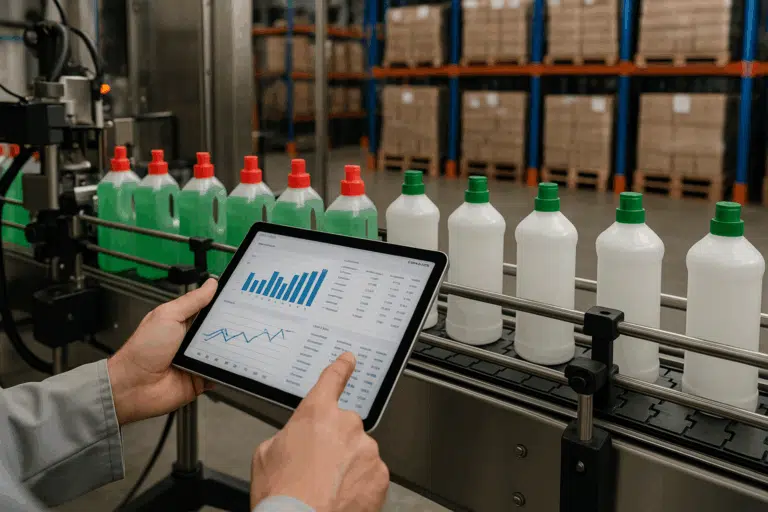At CPCON, we are experts in inventory management and pioneers in the use of RFID. We understand the critical role of efficiency and accuracy in manufacturing operations. But what is an RFID tracking system for manufacturing? Simply put, it’s a technology that uses radio waves to automatically track and identify objects. This article explores how RFID tracking systems can revolutionize your manufacturing processes, enhancing inventory accuracy, operational efficiency, and cost savings. Read on to discover the details and benefits of this innovative technology.
Table of Contents
ToggleKey Takeaways
RFID Tracking System for Manufacturing provides:
- Real-time tracking and visibility;
- Improved inventory accuracy and reduced errors;
- Enhanced operational efficiency and cost savings;
- Flexibility and customization for various manufacturing environments.
What is an RFID Tracking System?

RFID (Radio Frequency Identification) tracking systems are designed to improve the efficiency and accuracy of tracking and managing assets in manufacturing environments. By using radio waves, these systems can identify and track objects automatically, providing real-time data and insights. Let’s dive into the key components and types of RFID tags used in these systems.
Definition and Components
RFID (Radio Frequency Identification) is a technology that uses radio waves to transmit data from RFID tags to RFID readers, which then process this information. An RFID tracking system consists of three main components: RFID tags, RFID readers, and management software.
RFID Tags
RFID tags are small devices containing an integrated circuit and an antenna. These tags come in various forms and functionalities to suit different needs in manufacturing:
- Passive RFID Tags: These do not have an internal power source and rely on the energy emitted by the RFID reader. They are lightweight and cost-effective, ideal for short-range tracking.
- Active RFID Tags: These contain an internal battery that powers the transmission of signals. They are larger and more expensive but suitable for long-range tracking and monitoring high-value items.
- Semi-passive RFID Tags: These combine features of both passive and active tags, making them useful for environmental monitoring as long as they remain within the reader’s vicinity.
RFID Readers
RFID readers emit a radio signal that is reflected by nearby RFID tags, capturing data such as the identification and location of the item. Readers can be fixed or mobile, providing flexibility in data collection at various points in the manufacturing process.
Management Software
Management software processes and organizes the data collected by the RFID readers, providing real-time visibility of assets and inventory. This software is often integrated with existing ERP and WMS systems, enhancing data management and decision-making.
Types of RFID Tags

RFID tags are a crucial component of RFID tracking systems, with different types serving various purposes.
Passive RFID Tags
Passive RFID tags do not have an internal power source. They function by reflecting the energy from RFID readers to transmit their data.
- Advantages: Lightweight, cost-effective, no internal battery required.
- Disadvantages: Limited read range, require high-powered readers.
- Applications: Inventory tracking and smaller items.
Active RFID Tags
Active RFID tags have an internal battery that powers the transmission of data, enabling a stronger and longer-range signal.
- Advantages: Longer read range, stronger signal.
- Disadvantages: Higher cost, larger size due to internal battery.
- Applications: Monitoring high-value assets and large areas.
Semi-passive RFID Tags
Semi-passive RFID tags combine elements of both passive and active tags. They have a battery to power the chip’s circuitry but rely on the reader for signal transmission.
- Advantages: Environmental monitoring capabilities, combines passive and active features.
- Disadvantages: Dependence on proximity to readers, intermediate cost.
- Applications: Scenarios requiring detailed environmental monitoring.
RFID tracking systems are powerful and versatile tools for manufacturing, providing real-time visibility and accuracy in asset management. In the next section, we will explore how these systems work in a manufacturing environment.
How RFID Tracking Systems Work in Manufacturing?

RFID tracking systems streamline manufacturing processes by offering real-time tracking and precise identification of assets. This technology enhances efficiency, reduces manual labor, and minimizes errors.
Basic Working Principle
RFID systems use radio waves to communicate between tags and readers. When an RFID tag comes within range of a reader, it transmits data stored on the tag to the reader. The reader then processes this data and sends it to the management software, providing real-time information on the location and status of assets.
Real-Time Data and Accuracy
RFID tracking systems offer significant advantages in terms of data accuracy and real-time monitoring. By providing instant updates on the movement and status of materials, these systems help manufacturers optimize workflows and reduce downtime.
Key Components and Their Roles
- RFID Tags: Attached to items to provide unique identification.
- RFID Readers: Capture data from tags and transmit it to the system.
- Management Software: Processes data and provides actionable insights.
Workflow Integration
RFID systems integrate seamlessly with existing manufacturing workflows, automating data capture and reducing the need for manual intervention. This integration ensures that accurate data is always available, facilitating better decision-making and process optimization.
Examples of RFID Use in Manufacturing
- Inventory Management: Automatically track inventory levels, reducing the need for manual counts and preventing stockouts.
- Asset Tracking: Monitor the location and status of tools and equipment, ensuring they are available when needed.
- Quality Control: Track production processes in real-time, ensuring compliance with quality standards and reducing defects.
Benefits of RFID Tracking Systems in Manufacturing

The adoption of RFID tracking systems in manufacturing offers numerous benefits, ranging from improved inventory accuracy to enhanced operational efficiency.
Improved Inventory Management
RFID systems provide real-time visibility into inventory levels, enabling manufacturers to maintain optimal stock levels and reduce excess inventory.
- Advantages: Real-time tracking, reduced manual counting, better stock management.
- Impact: Lower inventory costs, fewer stockouts, improved order fulfillment.
Enhanced Asset Tracking
RFID technology allows for precise tracking of assets, ensuring that tools and equipment are always accounted for and available when needed.
- Advantages: Accurate location tracking, reduced asset loss, improved utilization.
- Impact: Reduced downtime, better maintenance scheduling, increased productivity.
Operational Efficiency
By automating data capture and reducing manual tasks, RFID systems streamline manufacturing processes and increase efficiency.
- Advantages: Automation, reduced manual labor, faster data processing.
- Impact: Lower labor costs, faster production cycles, improved overall efficiency.
Cost Savings
The implementation of RFID tracking systems can lead to significant cost savings by reducing labor costs, minimizing errors, and optimizing inventory levels.
- Advantages: Lower labor costs, fewer errors, optimized inventory.
- Impact: Increased profitability, better resource allocation, reduced operational costs.
Enhanced Decision-Making
Real-time data provided by RFID systems enables manufacturers to make informed decisions quickly, improving overall business agility.
- Advantages: Access to real-time data, better insights, faster decision-making.
- Impact: Improved responsiveness, better strategic planning, enhanced competitive advantage.
Integration with Existing Systems
RFID tracking systems can be integrated with existing ERP and WMS systems, enhancing overall data management and providing a unified view of operations.
- Advantages: Seamless integration, improved data accuracy, unified system.
- Impact: Better coordination, enhanced data visibility, streamlined operations.
Sustainability and Compliance
RFID technology supports sustainability efforts by reducing waste and improving resource efficiency. It also helps manufacturers comply with regulatory requirements by providing detailed tracking and reporting capabilities.
- Advantages: Reduced waste, better resource efficiency, regulatory compliance.
- Impact: Improved sustainability, reduced environmental impact, enhanced compliance.
RFID tracking systems offer numerous benefits that can transform manufacturing operations, leading to improved efficiency, cost savings, and better decision-making. In the next section, we will discuss the challenges and solutions associated with implementing RFID technology in manufacturing environments.
Integration with Existing Systems

Integrating RFID tracking systems with existing ERP and WMS systems can significantly enhance data management and operational efficiency. Seamless integration ensures that all data is centralized and accessible, improving decision-making and process optimization.
Benefits of Integration
Seamless Data Flow
Integrating RFID systems with ERP and WMS allows for a continuous flow of data between systems. This ensures that inventory levels, asset status, and production data are always up-to-date and accurate.
- Advantages: Real-time data synchronization, improved accuracy, better visibility.
- Impact: Enhanced decision-making, streamlined operations, reduced errors.
Enhanced Process Automation
Integration with existing systems automates various processes, reducing the need for manual intervention and minimizing errors. This automation leads to more efficient workflows and better resource utilization.
- Advantages: Reduced manual tasks, fewer errors, faster processes.
- Impact: Increased efficiency, lower labor costs, improved productivity.
Unified View of Operations
A unified system provides a comprehensive view of all operations, from inventory management to production tracking. This holistic view helps in identifying bottlenecks, optimizing processes, and improving overall efficiency.
- Advantages: Comprehensive data visibility, better process control, improved efficiency.
- Impact: Better coordination, optimized workflows, enhanced performance.
Steps for Successful Integration
- Evaluate Existing Systems: Assess current ERP and WMS systems to determine compatibility with RFID technology.
- Choose the Right RFID Solution: Select an RFID system that meets your specific needs and integrates seamlessly with your existing systems.
- Plan the Integration Process: Develop a detailed integration plan, including timelines, resources, and milestones.
- Implement the Integration: Execute the integration plan, ensuring that all systems are connected and data flows smoothly.
- Test and Validate: Conduct thorough testing to ensure that the integrated system works as expected and data is accurate.
- Train Staff: Provide training to staff on using the integrated system effectively.
Common Challenges
- Compatibility Issues: Ensuring that the RFID system is compatible with existing ERP and With existing ERP and WMS systems can present compatibility challenges. Ensuring that the chosen RFID system integrates smoothly with current software is crucial for a successful implementation.
- Data Inconsistencies: Merging data from different systems can lead to inconsistencies. Regular data audits and validation checks are necessary to maintain data integrity.
- Cost and Time: Integration projects can be costly and time-consuming. Detailed planning and resource allocation are essential to manage these aspects effectively.
Integration with Existing Systems

Integrating RFID tracking systems with existing ERP (Enterprise Resource Planning) and WMS (Warehouse Management System) platforms can greatly enhance data management and operational efficiency. This integration ensures a seamless flow of information, providing a comprehensive view of the manufacturing process.
Benefits of Integration
Seamless Data Flow
Integrating RFID systems with ERP and WMS platforms allows for continuous data flow. This ensures real-time updates and accuracy in inventory and asset management.
- Advantages: Real-time synchronization, improved data accuracy, enhanced visibility.
- Impact: Better decision-making, streamlined operations, reduced errors.
Enhanced Process Automation
Automation is one of the key benefits of integration. It reduces the need for manual data entry, minimizing errors and speeding up processes.
- Advantages: Reduced manual tasks, fewer errors, faster processes.
- Impact: Increased efficiency, lower labor costs, improved productivity.
Unified View of Operations
A unified system provides a holistic view of operations, from inventory management to production tracking. This helps identify bottlenecks and optimize processes.
- Advantages: Comprehensive data visibility, better process control, improved efficiency.
- Impact: Better coordination, optimized workflows, enhanced performance.
Steps for Successful Integration
- Evaluate Existing Systems: Assess current ERP and WMS platforms to determine compatibility with RFID technology.
- Choose the Right RFID Solution: Select an RFID system that meets your specific needs and integrates seamlessly with existing systems.
- Plan the Integration Process: Develop a detailed integration plan, including timelines, resources, and milestones.
- Implement the Integration: Execute the integration plan, ensuring smooth data flow and system functionality.
- Test and Validate: Conduct thorough testing to ensure the integrated system works as expected and data is accurate.
- Train Staff: Provide training to staff on using the integrated system effectively.
Common Challenges
Compatibility Issues
Ensuring compatibility between RFID systems and existing ERP/WMS platforms can be challenging. It’s essential to choose compatible technologies and work closely with vendors.
Data Inconsistencies
Merging data from different systems can lead to inconsistencies. Regular audits and validation checks are necessary to maintain data integrity.
Cost and Time
Integration projects can be expensive and time-consuming. Proper planning and resource allocation are crucial to manage these aspects effectively.
Overcoming Challenges
Compatibility Solutions
Work with RFID and software vendors to ensure compatibility. Custom integration solutions may be required to address specific needs and ensure seamless data flow.
Data Management
Implement robust data management practices, including regular audits and validation checks, to ensure data consistency and accuracy across all systems.
Planning and Resources
Allocate sufficient time and resources for the integration project. Develop a detailed project plan with timelines, milestones, and resource allocation to manage costs and ensure timely completion.
Challenges and Solutions

Implementing RFID tracking systems in manufacturing can present several challenges. However, with the right strategies, these challenges can be effectively addressed.
Environmental Challenges
Manufacturing environments can be harsh, with extreme temperatures, moisture, and chemical exposure. RFID tags must be durable enough to withstand these conditions without performance degradation.
Solution: Use high-temperature and rugged RFID tags designed for harsh environments. These tags are built to endure extreme conditions and maintain their functionality.
Metal Interference
Metal surfaces can reflect RFID signals, causing interference and reducing tracking accuracy. This is common in manufacturing settings where metal is prevalent.
Solution: Specialized RFID tags and reader setups can mitigate metal interference. Using tags designed for metal surfaces and adjusting reader placement can improve signal accuracy and reliability.
Data Security
RFID systems involve the transmission of sensitive data, making security a critical concern. Unauthorized access or data breaches can compromise the system’s integrity.
Solution: Implement robust security measures, such as encryption and access control, to protect data. Regular security audits and updates help maintain system security.
Integration Complexity
Integrating RFID systems with existing manufacturing processes and systems can be complex. Compatibility issues and data inconsistencies may arise.
Solution: Conduct thorough compatibility assessments and work with experienced vendors to ensure seamless integration. Implementing a phased integration approach can help manage complexity and minimize disruptions.
Cost and ROI
The initial cost of implementing an RFID system can be high, making it challenging to justify the investment. Demonstrating the return on investment (ROI) is crucial for gaining stakeholder support.
Solution: Focus on the long-term benefits of RFID, such as cost savings from reduced labor, increased efficiency, and improved inventory management. Providing case studies and ROI analyses can help build a strong business case for RFID implementation.
Employee Training
Adopting new technology requires training employees to ensure they can use the system effectively. Resistance to change can also be a barrier.
Solution: Provide comprehensive training programs and resources to employees. Highlighting the benefits of RFID systems can help mitigate resistance and encourage adoption.
Implementing RFID tracking systems in manufacturing presents challenges, but with careful planning and the right strategies, these challenges can be overcome. The benefits of improved efficiency, accuracy, and cost savings make RFID a valuable investment for manufacturing operations.
By addressing these challenges and leveraging the benefits of RFID technology, manufacturers can enhance their operations and gain a competitive edge in the market.
Industry-Specific Use Cases

RFID tracking systems have diverse applications across various manufacturing industries. Each industry has unique requirements and benefits from tailored RFID solutions. Let’s explore how RFID technology is transforming different manufacturing sectors.
Automotive Manufacturing
RFID in automotive manufacturing helps streamline production processes, ensure quality control, and track parts and components throughout the supply chain.
- Production Line Efficiency: RFID tags attached to car parts enable real-time tracking, ensuring the correct parts are used in assembly. This reduces errors and improves production efficiency.
- Quality Control: RFID systems provide detailed data on each component’s history, helping identify and address quality issues promptly.
- Inventory Management: Real-time tracking of parts inventory ensures that production lines have the necessary components without delays.
Key Benefits
| Benefit | Impact |
|---|---|
| Improved Accuracy | Ensures correct parts are used |
| Enhanced Quality Control | Quick identification of defects |
| Real-Time Inventory Management | Avoids production delays |
Pharmaceutical Manufacturing
In the pharmaceutical industry, RFID tracking ensures regulatory compliance, improves traceability, and enhances inventory management.
- Regulatory Compliance: RFID systems help track the production and distribution of pharmaceutical products, ensuring compliance with regulations.
- Traceability: Detailed tracking of raw materials and finished products improves traceability, which is crucial for recalls and quality assurance.
- Inventory Management: Real-time inventory data helps manage stock levels, reducing waste and ensuring availability of critical supplies.
Key Benefits
- Enhanced Traceability: Detailed tracking from raw materials to finished products.
- Regulatory Compliance: Helps meet stringent industry regulations.
- Optimized Inventory: Reduces waste and ensures availability.
Food and Beverage Manufacturing
RFID technology improves traceability, ensures food safety, and enhances inventory management in the food and beverage industry.
- Traceability: RFID tags provide detailed tracking of ingredients and finished products, ensuring traceability throughout the supply chain.
- Food Safety: RFID systems help monitor storage conditions and ensure compliance with food safety regulations.
- Inventory Management: Real-time tracking helps manage inventory levels, reducing waste and ensuring the freshness of products.
Key Benefits
| Benefit | Impact |
|---|---|
| Improved Traceability | Ensures full supply chain visibility |
| Enhanced Food Safety | Monitors storage conditions |
| Optimized Inventory | Reduces waste and ensures product freshness |
Electronics Manufacturing
RFID systems enhance asset tracking, ensure quality control, and streamline production processes in electronics manufacturing.
- Asset Tracking: RFID tags help track high-value components and equipment, ensuring their availability and reducing loss.
- Quality Control: Detailed tracking of components ensures compliance with quality standards and helps identify defects.
- Production Efficiency: Real-time data on production processes helps optimize workflows and reduce downtime.
Key Benefits
- Accurate Asset Tracking: Reduces loss and ensures availability.
- Quality Assurance: Detailed tracking helps maintain high standards.
- Improved Efficiency: Optimizes production workflows.
Advanced Technologies and RFID

Integrating RFID with advanced technologies like IoT and AI significantly enhances manufacturing processes, providing deeper insights and greater efficiency. Let’s explore how these technologies work together to revolutionize manufacturing.
IoT Integration
Combining RFID with the Internet of Things (IoT) allows for advanced monitoring and control of manufacturing operations. IoT devices can collect and transmit data from RFID tags, providing real-time visibility into every aspect of the production process.
- Real-Time Monitoring: IoT-enabled RFID systems offer continuous tracking and monitoring of assets, helping to quickly identify and resolve issues.
- Data Analytics: Data collected from RFID tags can be analyzed to improve decision-making and optimize operations. This includes tracking asset usage, maintenance needs, and inventory levels.
Key Benefits
| Benefit | Impact |
|---|---|
| Enhanced Visibility | Continuous tracking and monitoring |
| Improved Decision-Making | Data-driven insights for optimization |
| Predictive Maintenance | Early detection of potential issues |
AI and Machine Learning
Artificial Intelligence (AI) and Machine Learning (ML) can be integrated with RFID systems to provide advanced analytics and predictive capabilities.
- Predictive Maintenance: AI algorithms can analyze data from RFID tags to predict when equipment will need maintenance, reducing downtime and extending asset life.
- Operational Optimization: Machine learning models can identify patterns and trends in the data, suggesting ways to improve efficiency and reduce costs.
- Quality Control: AI can help in real-time quality monitoring by analyzing data from the production line, ensuring consistent product quality and compliance with standards.
Key Benefits
- Reduced Downtime: Predictive maintenance minimizes unexpected equipment failures.
- Cost Savings: Operational efficiencies and preventive maintenance lower overall costs.
- Improved Quality: Continuous monitoring and real-time adjustments enhance product quality.
Future Trends
The future of RFID in manufacturing looks promising, with continuous advancements in technology and increasing adoption across industries.
- Greater IoT Integration: More devices and sensors will be connected, providing comprehensive visibility and control.
- Enhanced Data Analytics: Advances in AI and ML will offer deeper insights and more accurate predictions.
- Sustainability Focus: RFID technology will play a crucial role in improving sustainability by optimizing resource use and reducing waste.
By leveraging these advanced technologies, manufacturers can significantly enhance their operations, leading to increased efficiency, reduced costs, and improved product quality.
Case Studies
Examining real-world examples of RFID implementations provides valuable insights into the practical benefits and challenges of the technology. Here are some case studies highlighting successful RFID applications in manufacturing.
Automotive Manufacturing: Toyota
Toyota implemented RFID tracking systems to enhance their production line efficiency and ensure quality control. RFID tags were attached to car parts, enabling real-time tracking and reducing assembly errors.
- Results:
- Improved Accuracy: Ensured the correct parts were used, reducing errors by 20%.
- Enhanced Quality Control: Real-time data allowed for immediate identification of defects.
- Operational Efficiency: Streamlined workflows and reduced production delays.
Pharmaceutical Manufacturing: Pfizer
Pfizer used RFID to track the production and distribution of pharmaceutical products, ensuring regulatory compliance and improving traceability.
- Results:
- Regulatory Compliance: Met stringent industry regulations with detailed tracking.
- Enhanced Traceability: Improved ability to trace products through the supply chain.
- Inventory Management: Reduced waste and ensured the availability of critical supplies.
Electronics Manufacturing: Samsung
Samsung integrated RFID technology to improve asset tracking and streamline production processes. RFID tags were used to monitor high-value components and equipment.
- Results:
- Accurate Asset Tracking: Reduced loss of high-value components by 15%.
- Quality Assurance: Enhanced compliance with quality standards.
- Production Efficiency: Optimized workflows, reducing downtime by 10%.
Key Benefits of RFID in Case Studies
| Company | Industry | Key Benefits |
|---|---|---|
| Toyota | Automotive | Improved accuracy, quality control, efficiency |
| Pfizer | Pharmaceutical | Regulatory compliance, traceability, inventory management |
| Samsung | Electronics | Accurate asset tracking, quality assurance, efficiency |
These case studies demonstrate the transformative impact of RFID technology across various manufacturing industries. By adopting RFID systems, companies can achieve significant improvements in accuracy, efficiency, and overall operational performance.
For more detailed examples and insights, explore our RFID case studies and discover how leading manufacturers are leveraging this technology to stay competitive.
Future Trends in RFID Tracking for Manufacturing
The landscape of RFID technology is continually evolving, with new advancements and applications emerging across industries. Let’s explore some of the future trends that are set to shape the use of RFID in manufacturing.
Greater IoT Integration
Integration with the Internet of Things (IoT) is becoming more prevalent, allowing RFID systems to provide even greater connectivity and data sharing.
- Smart Factories: IoT-enabled RFID systems can connect with other smart devices on the factory floor, creating a fully integrated manufacturing environment.
- Real-Time Data: Enhanced data collection and real-time analytics enable better decision-making and process optimization.
- Predictive Maintenance: IoT sensors combined with RFID can monitor equipment health, predicting maintenance needs before failures occur.
Key Benefits
| Benefit | Impact |
|---|---|
| Enhanced Connectivity | Better integration with other smart devices |
| Improved Analytics | Real-time data for better decision-making |
| Maintenance Efficiency | Predictive maintenance reduces downtime |
Advances in AI and Machine Learning
Artificial Intelligence (AI) and Machine Learning (ML) are set to revolutionize RFID applications, providing deeper insights and greater automation.
- Advanced Analytics: AI algorithms can analyze vast amounts of RFID data, uncovering patterns and insights that humans might miss.
- Automation: ML models can automate routine tasks, such as inventory management and quality control, reducing the need for manual intervention.
- Improved Accuracy: AI-enhanced RFID systems can improve the accuracy of tracking and monitoring, reducing errors and increasing efficiency.
Sustainability and Green Manufacturing
Sustainability is becoming a key focus in manufacturing, and RFID technology is playing a crucial role in promoting green practices.
- Resource Optimization: RFID systems help optimize the use of resources, reducing waste and improving efficiency.
- Energy Efficiency: RFID-enabled smart factories can monitor and manage energy use, contributing to overall sustainability efforts.
- Regulatory Compliance: RFID technology helps manufacturers comply with environmental regulations by providing detailed tracking and reporting capabilities.
Expanded Applications
New Applications for RFID technology are continually being developed, expanding its use across various sectors.
- Healthcare: Beyond manufacturing, RFID is being used to track medical equipment and ensure patient safety in hospitals.
- Retail: RFID is enhancing inventory management and customer experience in retail environments.
- Supply Chain: RFID technology is improving visibility and efficiency across entire supply chains, from raw materials to finished products.
Future Outlook
The future of RFID in manufacturing is bright, with continuous advancements driving greater efficiency, accuracy, and sustainability. As technology evolves, manufacturers will increasingly rely on RFID systems to stay competitive and meet the demands of a rapidly changing market.
Conclusion
In conclusion, RFID tracking systems offer significant benefits for manufacturing, including enhanced inventory management, improved asset tracking, and greater operational efficiency. By integrating RFID with advanced technologies like IoT and AI, manufacturers can achieve even greater levels of productivity and accuracy.
RFID technology is evolving rapidly, with future trends pointing towards greater IoT integration, advanced AI analytics, and expanded applications across various industries. These advancements promise to further revolutionize manufacturing processes, driving efficiency, sustainability, and innovation.
Ready to transform your manufacturing operations with RFID technology? Contact us today to learn how CPCON can help you implement cutting-edge RFID solutions tailored to your needs. Visit our contact page to get started.
FAQs
What are the main components of an RFID tracking system?
An RFID tracking system has three main parts: RFID tags, RFID readers, and management software. The tags store data, the readers capture it, and the software processes and organizes it.
How do passive and active RFID tags differ?
Passive RFID tags have no battery and rely on the reader for power. Active RFID tags have a battery and transmit signals over longer distances.
What are the benefits of integrating RFID with ERP systems?
Integrating RFID with ERP systems improves data accuracy, streamlines operations, and enhances decision-making by providing real-time inventory and asset information.
Are there any challenges in implementing RFID in manufacturing?
Yes, challenges include compatibility with existing systems, environmental factors, data security, and initial costs. Proper planning and robust solutions can mitigate these issues.
How does RFID technology enhance inventory management?
RFID provides real-time tracking of inventory, reducing the need for manual counts and ensuring accurate stock levels, which helps prevent overstocking or stockouts.
What are the future trends in RFID technology?
Future trends include greater IoT integration, advances in AI and machine learning, and expanded applications in various sectors like healthcare, retail, and supply chain.
How can RFID improve regulatory compliance in manufacturing?
RFID tracks production and distribution processes in detail, ensuring compliance with industry regulations through accurate and comprehensive data reporting.
What are some successful case studies of RFID implementation in manufacturing?
Successful case studies include Toyota’s improved production efficiency, Pfizer’s enhanced regulatory compliance, and Samsung’s optimized asset tracking.


























